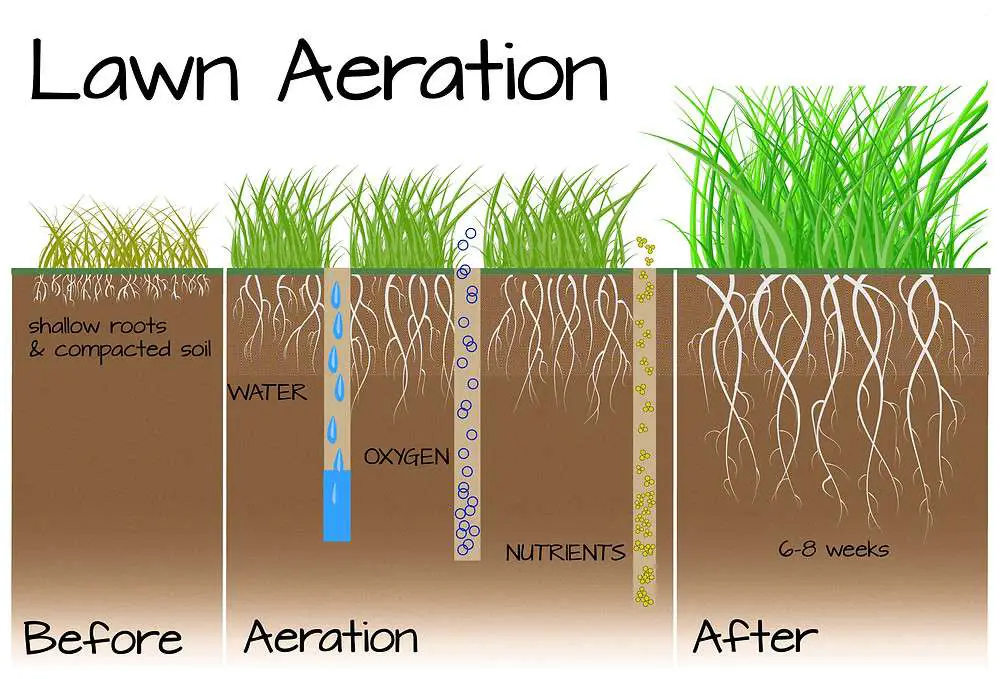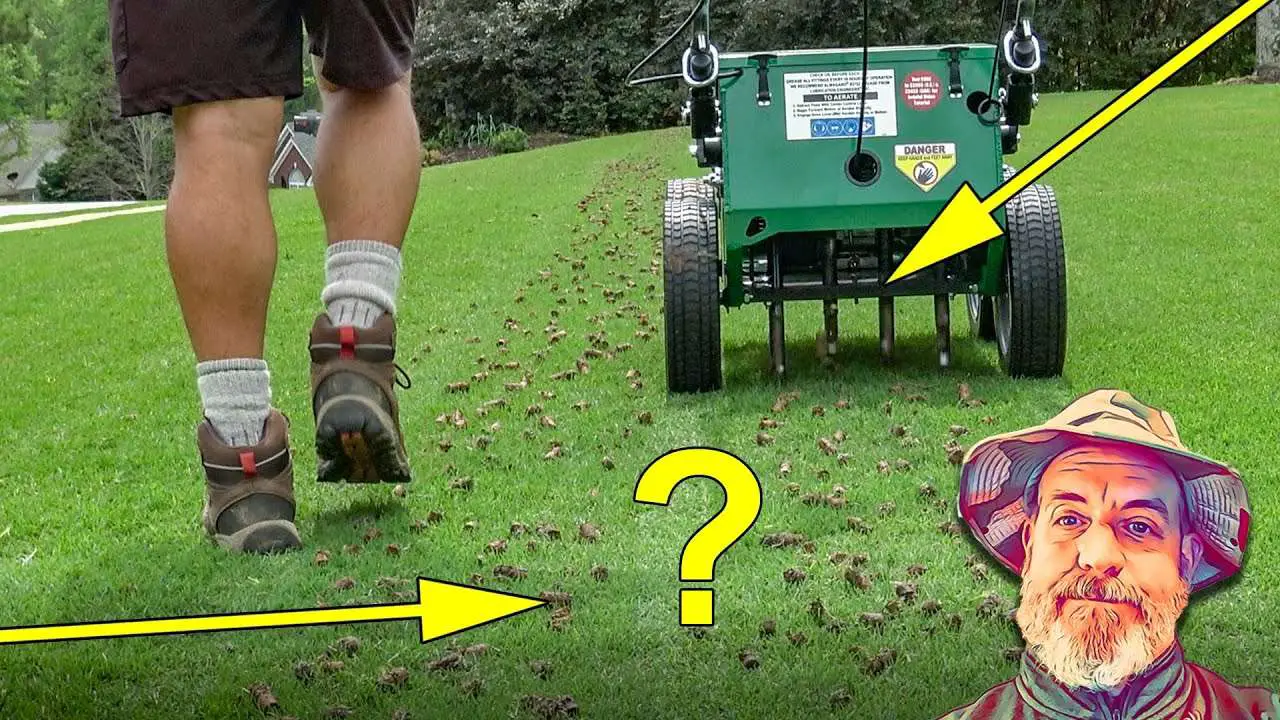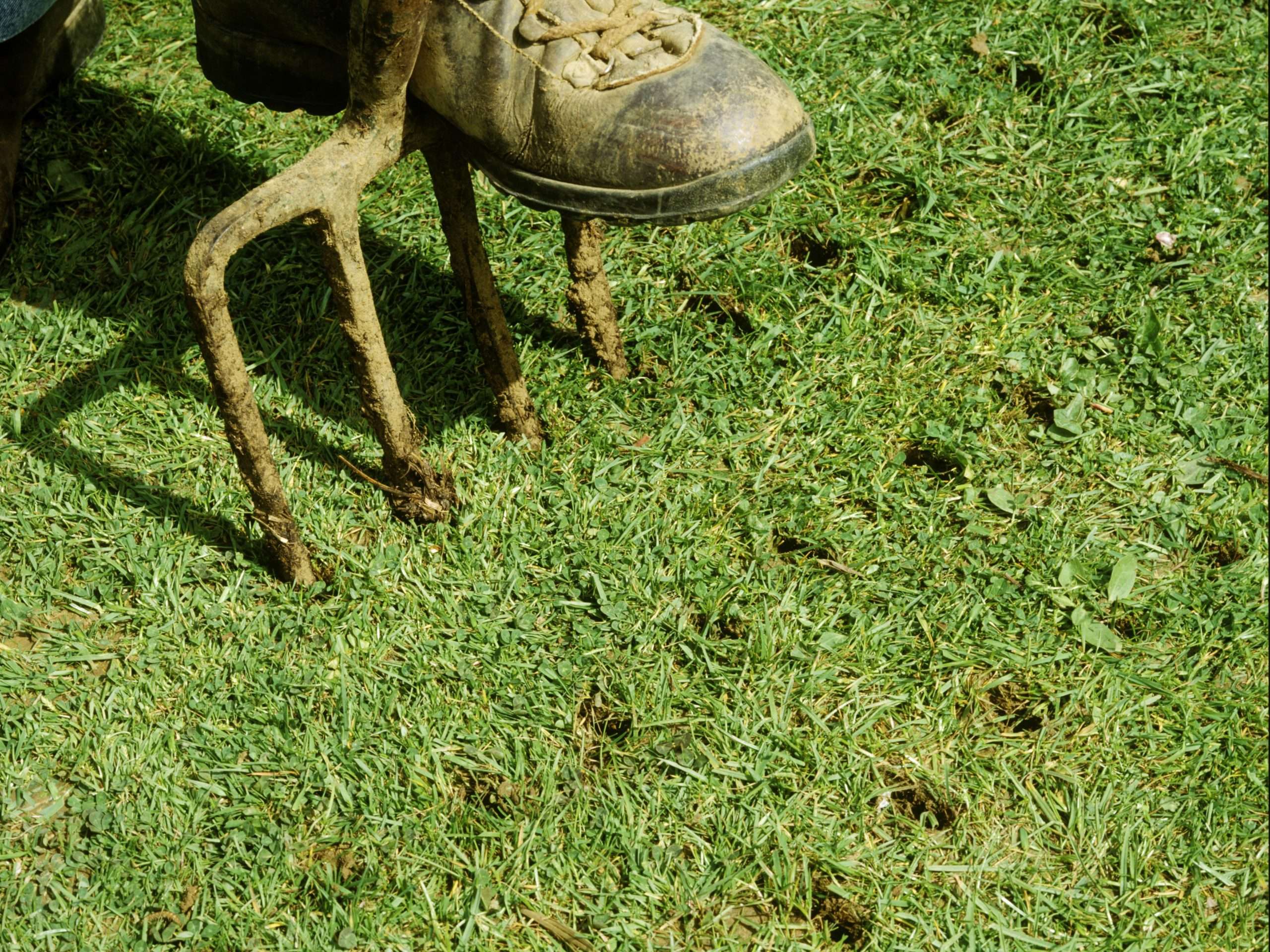Fertilizing Your Lawn After Aeration
It is a good idea to use fertilizer during the process of your annual lawn maintenance routine but you have to make sure you use the right kind when you are planning to add fresh grass seeds.
You definitely dont want to use an all in one weed and feed fertilizer as the portion of that type of fertilizer that is designed to stop weeds from growing may actually stop fresh grass seeds from germinating.
During this aeration process, I normally do the aeration and then add fertilizer straight away as I feel my lawn gets the most benefit from fertilization when the fertilizer has a chance to go deep down into the aeration holes where it can give the root zone a welcome boost.
This is basically the only time it is possible to directly boost the root zone of your lawn and that is why I choose to fertilize at this stage of the process.
Some people may advise that you should fertilize your lawn a few days before you aerate and overseed but I am telling you the exact process I have carried out many times and it has always worked out well for my lawn.
How Long Until Ill See Healthy Grass
Whether you fertilize and aerate together or just fertilize your lawn, you should see results within six to eight weeks. The combination of the two is often the best option, especially if you have compacted soil or clay soil. Of course, aerating and fertilizing arent the only ways you should be taking care of your lawn. Proper mowing and watering are essential for any lawn to be vibrant and green.
Adding Topsoil After Aeration
Ok, so I do recommend you add topsoil to your lawn after you aerate it, but not every time.
I would recommend you add a thin layer of topsoil to your lawn maybe every second or third year but this all depends on the health of your lawn.
You will have to use your judgment when it comes to the health of your lawn against do you want to go on your lawn for the summer because when you add topsoil it is best that you trample on it as little as possible for several months at best and the whole summer at worst.
I recommend topdressing your lawn with topsoil as there are many benefits and these include:
- Topdressing with fresh topsoil will add nutrients to the soil underneath.
- Adding topsoil is the best way to smooth out any bumps in your lawn.
- Adding topsoil will help control the naturally occurring thatch build up in your lawn.
- If you have overseeded your lawn it will help the seeds germinate by boosting the fresh organic content of your lawn.
When you are adding topsoil even id you want to add a good thick layer you should always have 75% of the grass sticking out above it otherwise you have added too much. I only add a thin layer which I try to make only about ¼ of an inch deep at most.
Read Also: How Much Should I Pay A Teenager To Mow My Lawn
Here Are Some Of My Favorite Lawn Care Products
Thanks a lot for making it to the end of this post! I hope you found it useful. Here are some lawn care products that I use and that I think youll also find helpful. These are affiliate links, so if you do decide to use any of them, Ill earn a commission.
In all honesty, these are some of the basic products that I use and recommend to everyone.
Recommendations For Watering After Germination

When the new grass germinates, it definitely requires some extra TLC. New grass plants dont have the root systems of an established lawn. Therefore, new grass needs more attention until it matures, which can take anywhere from six to nine months. The goal is to keep the top 2-3 inches of soil moist during this early growth.
Following germination, youll want to water less frequently but using more water. The key is to soak the soil to a depth of two to three inches. This might mean watering two to three times a week .
During this phase, youre watering for a longer duration but not as often . You want to achieve soil saturation during this period of watering. This will allow the roots to grow deeper and help make your lawn more drought-tolerant in the long run.
How can you tell when the grass is mature enough to start to back off of this schedule?
As a very general rule of thumb, once grass gets long enough to mow, you can feel confident its progressing as it should. After youve mowed three or four times, its likely fairly well-established and you can start to back off of watering as frequently as youve been.
Recommended Reading: Lowes Troy Bilt Zero Turn Mower
Do You Really Need To Aerate Your Lawn
All lawns are not created equal, so different turfs need different levels of care and aeration to stay in tip-top shape. If you want to have a decent looking patch, this process really cant be ignored.
Lawn aeration improves the overall health of your grass by giving the root zone better access to essentials such as air, water, and fertiliser. This increased health helps the grass grow a more robust and more extensive network of roots.
Thatching is a particularly sore point for lawn-owners that aeration helps with, as the action brings thatch-decomposing micro-organisms from deep in the soil up to the top layer.
Aeration also helps to relieve soil compaction, which can cause dead patches and thinning in your lawn. Tightly packed soil stops the nutrients that roots need from reaching them, a problem which aeration solves by removing cores, which lowers soil density.
Aerating before and after seeding can also help the process along by creating a moist, protected environment for the little seedlings. Puddling and flooding is another problem to which you can bid farewell with aeration, as the action allows for much more drainage within your patch.
Can I Aerate The Lawn In The Rain
The quick answer is sure you can! But this is only recommended during light to moderate showers. A good, balanced amount of moisture actually makes it easier to penetrate heavy or severely compacted soil, especially if you are using roller-style aerators.
If its particularly heavy rainfall, then its generally a bad time to aerate your lawn. Firstly, theres the question of safety: wet grass can be slippery and dangerous. In addition, its best to wait a full day after extensive rain to aerate, giving the moisture a chance to drain away. Soil that is too moist is difficult to aerate and theres a chance your lawn will be damaged in the process.
Read Also: Rolled Lawn
Can I Fertilize Without Aerating
While not crucial, it is recommended to aerate your lawn before fertilizing or overseeding. It is important to make sure the soil is loose enough for seeding so the roots can grow deeper for better water and nutrient access. Aeration loosens up compacted soil, improving the supply of oxygen, nutrients and minerals to the new grass seed. By delivering more nutrients to the roots and strengthening them, lawns can grow stronger, quicker and denser.
Why You Should Aerate
Aeration is the antidote to the heavily compacted soil, which may be present on a lawn that gets very heavy foot traffic, or which is planted on a soil base that is heavy in clay content. It rarely is necessary where soils are on the sandy side. Core aeration is sometimes advertised as a solution to problems with thatch however, it does not do much to relieve that problem if thatch is already present. Where thatch is a genuine problem, a true dethatching operation is a better solution. However, dethatching is a fairly violent action to a lawn, and an annual core aeration may well prevent thatch problems in the first place.
If you have the type of soil and conditions that require lawn aeration, you can do it once each year. It does not hurt your lawn, and in fact, will make it healthier and more attractive. Some people dislike the look of the small plugs of soil and turf that are pulled up and scattered over the lawn, and if so, you can rake them up. Left on the lawn, though, they will quickly break up and decompose.
Also Check: Small Rider Mower
What To Do After Aerating
After you aerate, you should not simply walk away. Instead, you should consider seeding, watering, mowing, and fertilizing your lawn.
It is logical to do so now because the entire purpose of aerating is to make it easier for water and nutrients to reach the roots of your grass and help it grow. But the timing of all of these steps is critical.
Do Nothing After Aerating And Overseeding
After aerating and overseeding you have to ensure that the soil stays moist. This helps the seeds to start growing. If there is enough rain, youre fine. But when it is dryer, I recommend watering your lawn regularly.
When you see the new grass leaves appear, you can stop your additional watering scheme. You can expect this after 2 to 3 weeks.
Recommended Reading: How To Get Rid Of Lawn Rust
When Is The Best Time Of Year To Aerate
Timing is everything when it comes to aeration. If you get aeration-happy at the wrong time, you could end up severely harming your lawn instead of helping it grow. To time it properly, you need to consider both the season and the weather conditions.
Your season will be determined by the type of grass you have: you want to aerate at the beginning of the peak growing season. This will help your lawn quickly recover from the temporary damage aeration causes and promote maximum growth of the root system. If the grass is still completely brown, it is not the time to aerate! The grass should be greening first. For cool season turf like fescue, bluegrasses, and ryegrass, aerate in the fall. Much of the turf in Colorado Springs is cool season. For warm-season turf like Bermuda, Buffalo, and St. Augustine, the time to aerate is in late spring or early summer.
Weather conditions also must be right for aeration. Aeration does cause some root damage, so you need to avoid dry periods, heat waves, and cold snaps to avoid further stressing your lawn. While the soil should be moist, aeration also should not be done when it is overly soaked, or the soil will clump together and not be aerated properly.
Dethatching Vs Aerating: Do One Or Both

Much like compacted soil, excessive thatch buildup starves the soil of water and nutrients. A core aerator will help to break up thatch, but for best results, dethatch before aerating.
Dethatching your lawn will strip out the spongy layer of thatch on top of the soil. This will allow your core aerator to reach down to the soil more effectively. To bring life back to a failing, thin lawn, dethatch and then aerate.
You May Like: Peat Moss Vs Compost For Top Dressing Lawn
How Chorbie Can Care For Your Lawn
After aeration is the perfect time to focus on your lawn needs. Aeration adds extra exposure to your soil, helping new growth and lushness. Though it may sound complex, there are many known reasons to care for your lawn after aeration with intention and purpose. Follow these tips above to nourish a healthy lawn. Create beauty in your surroundings, and cultivate a stunning lawn. Contact Chorbies lawn care experts who specialize in helping homeowners get unique, impressive results.
What Equipment Do You Need For Aeration
There are different kinds of equipment that can be used for aeration.
Core or plug aerators are generally believed to be the best . A core or plug aerator will have hollow tines, arranged in rows. These will remove plugs of soil from your lawn and then put them back on top of the grass.
Some people wonder if they should mulch mow these core aeration plugs to help them break down quickly. I dont recommend that. Given time, these plugs will break down and add nutrients to the soil on their own schedule.
If you mow and chop those plugs up with your mower, that soil will drop right back into your aeration holes and fill them in. Thats not really what you want.
You May Like: Rgs For Lawns
What To Do Before Aerating Your Lawn
- Mow your lawn before watering and aerating it.
- Be sure to water your lawn thoroughly two days before aeration. The tines on the aeration machine penetrate loose soil better than dry soil. If the soil is too dry, the tines will have trouble effectively piercing the ground.
- Avoid aerating immediately after an extended period of rainfall. Soil thats too wet will stick to the inside of the tines instead of falling easily back into the lawn.
- Plan to pass over your lawn in two or more directions. This ensures a more even, thorough coverage. Most sources agree that you should aim for 20 to 40 holes per square foot.
Should I Fertilize My Lawn After Dethatching
4/5fertilizeyardafter dethatchingyardfertilizegrassgrass
Also question is, what should I do after I Dethatch my lawn?
If bare spots were created by dethatching, use a patching product, like Scotts® EZ Seed®, to repair them. Fertilize your lawn after dethatching to help the lawn recover. Do not fertilize before dethatching. Keep your lawn well-watered to help your grass recover.
Subsequently, question is, what to do after dethatching and aerating? Dethatch in two directions at a 90-degree angle from one another. If thatching leaves bare spots, reseed your lawn. Water the lawn well to help the grass recover. Aerate regularly in the future to prevent thatch build-up.
Likewise, can I fertilize before dethatching?
Unless the lawn has extremely heavy thatch buildup, regular aeration treatments would be better. Don’t fertilize the lawn for at least 45 days prior to dethatching. If you are planning to apply preemergence herbicides, do so after dethatching.
Should I overseed after dethatching?
First, you need to dethatch, then overseed and fertilize within a couple days. Mow a bit shorter than you normally would before you dethatch. Not only will this make the dethatching easier, but it will let more of the seed down to soil level. It would be best to use a grass catcher if you can.
Read Also: When To Overseed In Connecticut
The Argument Against Picking Up Plugs After Aerating
In most cases, you should leave the plugs wherever they end up. While things might look a little unkempt for a few days, its worth it as you will keep more nutrients and microorganisms on or in your lawn where they belong.
After a few normal watering sessions or a heavy rain, the plugs leftover after aerating should break down and become effectively invisible. As they break down they can restore any microorganism that they might be holding right away. Any dirt should wash back down into the ground. Organic matter, including dead grass and roots, may take a little while to decompose but as it does it will provide your lawn with nitrogen and other necessary nutrients.
One important thing to note is that allowing the plugs to break down where they end up will not create compaction in your lawn or impact the results of the aeration process in a meaningful way. The act of pulling these cores or plugs out of your lawn was sufficient to aerate your lawn, you do not need to remove these plugs from the surface of the lawn.
Things To Do After Aerating Your Lawn
Before you aerate your lawn, know your goals. Your goal could be to increase the density of your grass and fill in any thinning or bald patches. Or your goal could be to decrease the number of weeds in your yard and increase the health of your existing grass.
Once you know your goals and what products you will need, you can come up with a plan on how to apply them. Below are 6 things you may want to do after aerating your lawn. Remember to only apply the steps that work with your goals and consider the directions on any products you have purchased when developing your after-aeration plan.
Recommended Reading: How To Dispose Of A Gas Lawn Mower
When Should I Aerate Kikuyu Turf
As a warm season grass, kikuyu grass should be aerated during the growing season in spring and summer. This allows the grass to regrow and fill the holes from aeration. To help your grass recover after aeration, follow similar guidelines to watering new kikuyu turf and ensure the lawn stays moist.
Disclaimer:
This article is published for general informational purposes only and does not constitute professional advice. Any action you take upon the information you find on this website is strictly at your own risk. Always ensure you have the right qualifications and certifications to carry out DIY work and never put your safety at risk. Hills Irrigation recommends consulting a professional for all electrical and plumbing work.
Types Of Top Dressing To Use After Lawn Aeration

Our Florida Panhandle landscaping clients want their residential and commercial lawns to look their best, as in green, lush and with a consistent look. As summer gets into full swing, some of our clients are asking us whether they should aerate their lawns and add top dressing.
Before we answer that question, we thought it would be helpful to explain a bit more about how top dressing works and when aeration is helpful.
Also Check: Lowes Rent Aerator
